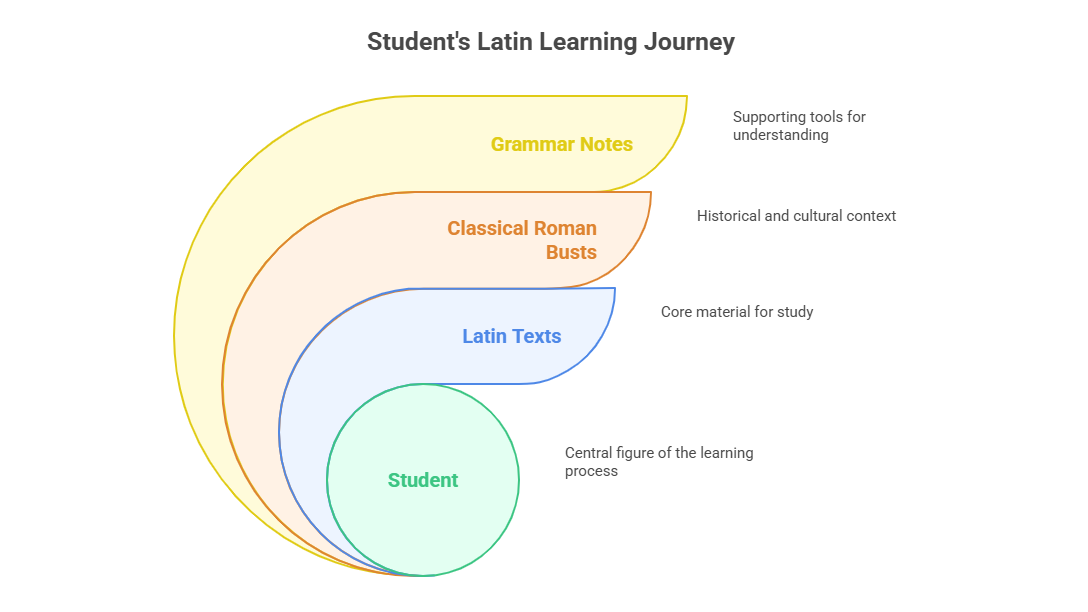How to Translate Latin with both accuracy and style is a question many students and scholars struggle with. Even those with solid grammar often find their work too stiff, unclear, or off-mark when trying to reflect the original meaning.
Latin isn’t just about getting the words right, it’s about capturing tone, rhythm, and purpose. I’ve seen countless learners frustrated when their translations feel flat or are picked apart in class or print.
As the founder of LatinPerDiem, I’ve helped thousands improve their Latin through clear, real-world tips. In this article, you’ll learn how to avoid common mistakes, improve clarity, and bring confidence to your work whether you’re preparing for exams, translating poetry, or working with ancient texts.
Key Takeaways
- Focus on Grammar First
Understanding cases, declensions, and verb forms is essential to accurate translation. - Break Down Sentence Structure
Learn to spot Latin word order tricks like hyperbaton to grasp true meaning. - Translate for Sense, Not Word-for-Word
Avoid rigid English, aim for natural, readable phrasing that reflects Latin intent. - Polish Your Final English
Style matters refine your version to match tone, rhythm, and clarity. - Watch Out for Common Mistakes
Don’t confuse cases or ignore idioms; Latin isn’t just “backward English.” - Use LatinPerDiem’s Daily Lessons
Short, focused videos help you practice smarter, not harder. - Stick to a Daily Routine
Just 10 minutes a day using real texts (like Cicero) builds lasting skill.
What Are the Best Latin Translation Tips for Accuracy and Style?
Latin translation is not just about swapping words it’s about understanding grammar, context, and tone. The best Latin translation tips focus on accuracy, clear English phrasing, and avoiding word-for-word mistakes. To succeed, you must know grammar rules, recognize sentence structure, and translate the sense, not just the syntax.
What Makes Latin Translation Different?
Latin translation is more than swapping Latin words for English ones. It’s about understanding grammar, style, and voice and capturing the author’s intent. At LatinPerDiem, we teach students how to move beyond word-for-word translation to uncover the true meaning behind each sentence.
Our popular Blog, “Learning Latin at Home,” gives learners a simple path: one Latin phrase per day. In just 10 minutes, you get practical help on declensions, syntax, and how to translate in context. Each clip offers a mini-lesson that connects the grammar rule to real reading practice. It’s designed for busy students, homeschoolers, and curious learners alike.
More importantly, we don’t just focus on textbook Latin. Our lessons center on classical authors like Cicero , showing how to decode complex phrases, rhetorical patterns, and historical meaning.
With daily exposure and guided analysis, learners build skills that go far beyond vocabulary into true classical fluency.
Why Accuracy in Latin Translation Matters
Preserving Classical Meaning
In Latin, accuracy means everything especially when dealing with classical texts. A small error in grammar or word order can change the entire meaning. For example, in Caesar’s Gallic War, phrases like “omnem Galliam in partes tres divisit” (he divided all Gaul into three parts) use word placement for emphasis, not just structure. A literal translation might miss Caesar’s tone or political nuance, weakening the impact of the original.
LatinPerDiem teaches learners how to read for meaning, not just words. This approach helps preserve the historical, cultural, and rhetorical force behind each line, something essential for accurate translation.
Supporting Students & Scholars
LatinPerDiem’s Latin Language for Students Blog gives learners structured help with real-world classical texts, not just drills. These lessons build up from grammar basics to full-text translations of authors like Cicero. For scholars, this means fewer missed meanings. For students, it leads to better exam performance and deeper understanding.
By focusing on accuracy, LatinPerDiem helps protect the legacy of classical literature one correctly translated line at a time.
Step‑by‑Step Latin Translation Tips
Getting Latin right takes more than a dictionary. It’s about thinking like a Roman one step at a time. LatinPerDiem teaches a proven method to make your translations more accurate and elegant.
Master the Grammar
Start with the basics. LatinPerDiem’s “Unit II – Cases & Declensions” explains how nouns change form based on meaning. Learning these case endings helps you spot subjects, objects, and direction quickly. Without this, translation is just guessing.
Break Down Sentence Structure
Latin sentences often use hyperbaton, a fancy term for unusual word order. LatinPerDiem’s Cicero video series shows how verb placement and separated phrases create emphasis. Breaking the sentence into chunks helps you rebuild it in English with clarity and power.
Context > Word‑for‑Word
Literal translations fall flat. LatinPerDiem’s “Practice Latin Reading Daily” guide teaches you to look at the whole sentence its tone, style, and intent. Focus on meaning, not mechanics.
Polish Your English Version
Once you have the Latin, don’t stop. Your English should sound natural and match the author’s voice. LatinPerDiem’s Cicero walkthroughs are perfect examples of polished, rhetorically rich translations that stay true to the text.
Use the Right Tools
You don’t need to go it alone. LatinPerDiem offers daily video lessons, clear grammar guides, and structured routines. Even 10 minutes a day can transform your skills over time.
“Latin is not a puzzle to solve it’s a voice to understand.” – LatinPerDiem Founder
By following these steps, you’ll move from word-for-word struggles to confident, classical-level translation.
Common Mistakes & Myths
Even eager Latin students fall into a few classic traps. LatinPerDiem’s lessons spotlight these common mistakes so you can avoid confusion and build real confidence.
Case Confusion
Each Latin case carries a specific meaning subject, object, direction, possession. Mix them up, and the sentence falls apart. As LatinPerDiem’s beginner lessons explain, even one wrong case ending can flip the message entirely.
Too Literal
A major myth is that Latin is just backward English. It’s not. Word-for-word translation often misses tone, rhythm, or hidden meaning. LatinPerDiem teaches you to focus on the structure of what the author meant, not just what they wrote.
Ignoring Idioms & Style
Latin isn’t just grammar, it’s art. Idioms, wordplay, and sound devices like alliteration carry cultural weight. LatinPerDiem’s style-based lessons, especially on Cicero, help you hear the music behind the words, not just the message.
Avoid these mistakes, and your Latin translation skills will leap forward with clarity and style.
Real Examples from LatinPerDiem
LatinPerDiem is a great resource for quick introductions to and explanations of a wide variety of Latin texts. From the “golden oldies” of Cicero and Caesar to authors who tend not to be covered in high school or undergraduate courses such as Theodore Beza and Lactantius, LatinPerDiem is a four- minute treat for anyone interested in the vast corpus of Latin literature.” – Michael K.
LatinPerDiem is a great and inspiring enterprise, from which I daily benefit. As an MA student in Theology, I especially appreciate the well-produced episodes from patristic authors, however the selections of the bonae litterae are also worth the time to explore and enjoy!” Christian V
David Noe has produced a wonderful resource in LatinPerDiem. It is highly recommended for anyone interested in engaging the past, including the Christian tradition in original sources and languages. R. Scott Clark
LatinPerDiem offers structured courses and daily lessons that have helped learners progress effectively. Their approach emphasizes understanding Latin in context, making the learning process more intuitive.
Tools, Resources & Checklist
LatinPerDiem offers simple, useful tools to help you practice Latin reading every day—without getting overwhelmed.
- Daily Video Archive – Short, guided readings with expert explanation
- Suggested Reading List – Curated texts for beginners and advanced learners
- Grammar Refresher Videos – Quick reviews of tricky Latin grammar and syntax
- LatinPerDiem Blog & Newsletter – Ongoing tips, updates, and reading encouragement
Conclusion
Latin translation is more than turning words into English. It’s about grammar, context, and style, not just literal meaning. With LatinPerDiem’s clear lessons, you learn to think in Latin, not just translate it. Take small, daily steps. Just one phrase a day from their video series can boost your skills faster than cramming once a week. Their bite-sized approach is perfect for students, teachers, or curious minds.
Frequently Asked Questions
How do I translate Latin without sounding too literal?
To avoid a stiff or robotic translation, focus on meaning and context, not just the words. LatinPerDiem teaches you how to translate sense-first, then refine your English version to sound natural. Literal word-for-word translation often leads to errors, especially with poetry or classical prose.
What’s the best daily routine for learning Latin translation at home?
A simple 10-minute daily routine works best. LatinPerDiem suggests translating just one Latin phrase a day using their free video series. This builds long-term grammar and vocabulary memory without overwhelm. Consistency matters more than cramming.
Can I use AI tools to translate Latin accurately?
Some People use AI for rough drafts, but AI tools often miss context, idioms, and stylistic choices—especially in classical texts. That’s why scholar-led tools like LatinPerDiem are essential. Human guidance ensures your translation is accurate, elegant, and culturally correct.
Why should I study Cicero or Caesar instead of Latin textbooks?
Classical authors like Cicero and Caesar teach real rhetoric, structure, and style. LatinPerDiem’s guided videos help you understand how educated Romans actually wrote and spoke. This improves both your reading fluency and writing accuracy in Latin.
Is Latin translation still useful today for students or professionals worldwide?
Yes. Latin is essential in law, medicine, history, theology, and linguistics. It also boosts critical thinking and grammar skills. Whether you’re in the UK, US, India, or Brazil, tools like LatinPerDiem make classical Latin accessible from anywhere.




